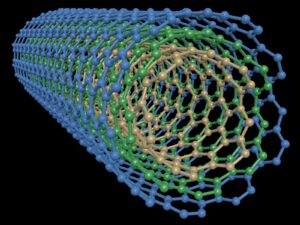Submicron particle generation of multi-wall carbon nanotubes
by August C. Krupp, Nancy M. Henderson and Emily Barton Cole, Molecular Rebar Design, LLC.
Multi-wall carbon nanotubes, if in an oil carbon nanotube form and bound to the rubber providing reinforcement, greatly reduce the risk of exposure to submicron particles throughout a tire’s life cycle.
The adoption of carbon nanotube (CNT) reinforcing systems on a global scale has been slow since
their invention some 20 years ago. The use of multi-wall carbon nanotubes (MWCNTs) in industrial
applications has been growing, but there are still major barriers to adoption. Concerns over the
environmental, health and safety aspects of the use of MWCNTs are one such major barrier to
widespread acceptance. While there have been numerous studies on the effects of CNTs in-vitro to
simulate the effects on the body, there have been relatively few studies demonstrating that the
CNTs would de-bond from the composite matrix during normal wear and tear, providing a method
for the CNTs to enter the body (refs. 1-7). Despite limited evidence of exposure, potential elastomer
customers and partners of Molecular Rebar Design, LLC, have expressed their concern in using
MWCNTs in abrasion- focused applications, and some potential customers have expressed
unwillingness to perform laboratory scale trials. While the rubber industry routinely works with
nanoscale particles such as precipitated silica and carbon black, the unknown ability of MWCNTs to
produce dust raises concerns regarding the appropriateness of personal protection or engineering
controls in place. Key concerns relate to laboratory workers preparing ingredients for rubber
compounding, specifically pouring powders containing nanoparticles from product packaging into a
container. Although DIN 55992 and EN 15051 are commonly utilized standards for measuring dust
particulates, dustiness is generally a difficult material property to quantify with accuracy via one
particular standard for different scenarios. To best replicate the concerns of industry
partners, dustiness levels are being quantified in field conditions using typical pouring methods and
containers, rather than the above stated standards.

